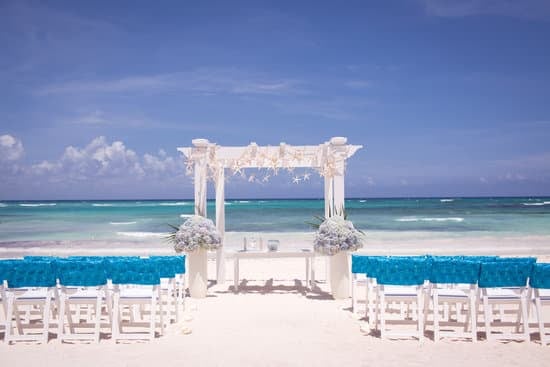At every wedding ceremony, one of the age-old traditions that guests often ponder upon is which side the bride will be seated on. The positioning of the bride and groom on opposite sides has been a long-standing custom that holds significant meaning in various cultures and religions. Understanding the roots and reasons behind this practice sheds light on its importance and symbolism in tying the knot.
Historically, the tradition of seating the bride on a specific side at weddings dates back to ancient times, with distinct reasons rooted in different cultures and belief systems. Exploring these historical origins offers insight into how societal norms and customs have shaped the way weddings are conducted today. From symbolism to practical considerations, each factor contributes to the overall significance of where the bride is positioned during her special day.
As weddings continue to evolve with modern trends reshaping traditional customs, there is a growing shift away from strict adherence to seating arrangements based on gender or familial affiliations. Contemporary ceremonies now offer more flexibility in determining where the bride should be situated, allowing for personal preferences to take precedence over rigid protocols. This shift reflects a broader movement towards customization and individual expression in celebrating love and unity.
Historical Origins
The tradition of seating the bride on a specific side at weddings has deep historical roots that date back centuries. One of the most commonly cited reasons for this tradition is based on medieval customs when brides were often kidnapped from neighboring villages or other clans.
Placing the bride on the left side of the groom was believed to make it easier for him to draw his sword and defend her against potential attackers. This practice evolved over time and became a symbolic gesture of protection and strength.
In addition to the protective symbolism, historical origins also point to religious beliefs playing a role in determining which side the bride sat at during a wedding. In Christian ceremonies, it is often customary for the bride to stand on the left side of the groom, as this aligns with Biblical references where Jesus sits at the right hand of God.
The positioning of the couple during the wedding ceremony was seen as a reflection of spiritual hierarchy and divine order.
Furthermore, in some cultures, seating arrangements for the bride at weddings were influenced by societal norms and gender traditions. For example, in certain Eastern cultures, where patriarchy was prevalent, placing the bride on a specific side signified her acceptance into her husband’s family and symbolized her transition from one household to another. These cultural variations highlight how customs surrounding weddings can be deeply intertwined with history, religion, and social structures.
| Historical Origins | Data |
|---|---|
| Protective Symbolism | Placing bride on left for protection |
| Religious Beliefs | Biblical references influencing wedding traditions |
| Cultural Influences | Societal norms shaping seating arrangements |
Cultural Variations
Traditional Hindu Weddings
In traditional Hindu weddings, the bride is typically seated on the left side of the groom. This placement is significant as it aligns with the belief that the heart is located on the left side of the body.
By placing the bride on this side, it symbolizes that she has taken up residence in her husband’s heart. Additionally, in some Hindu cultures, the groom is considered to be an embodiment of Lord Vishnu, who is often depicted reclining to his left with Goddess Lakshmi by his side.
Chinese Wedding Traditions
In Chinese culture, seating arrangements for the bride at weddings can vary depending on regional customs and family traditions. However, a common practice is for the bride to sit on the groom’s right side during the wedding ceremony. This positioning symbolizes harmony and balance between yin and yang energies.
In Chinese culture, yin represents femininity (the bride), while yang represents masculinity (the groom). Placing the bride on the right side of the groom is believed to create a harmonious union between these opposing forces.
Islamic Wedding Customs
In Islamic weddings, seating arrangements for the bride are often dictated by religious guidelines and cultural norms. It is traditional for Muslim brides to be seated on the left side of their husbands during wedding ceremonies.
This practice stems from Prophet Muhammad’s teachings that when a husband looks at his wife, he should do so with love and mercy in his heart. By having the bride seated to his left, it allows him to gaze at her with affection and tenderness during this sacred union.
Modern Trends
In recent years, modern trends in wedding ceremonies have seen a shift away from strict adherence to traditional seating arrangements for the bride. Couples are increasingly opting for more personalized and non-conventional approaches to their weddings, including the seating of the bride. This departure from the age-old practice of positioning the bride on a specific side has opened up new possibilities for creative and unique wedding experiences.
Personalized Seating Arrangements
One of the most significant modern trends in weddings is the emphasis on personalization and individuality. Many couples are choosing to forego the traditional seating arrangement that designates which side the bride should be seated on and instead opt for seating plans that reflect their personalities and relationships.
This may involve having both partners sit together at a sweetheart table, surrounded by their closest friends and family members, or even mixing up the sides to create a more inclusive and egalitarian atmosphere.
Breaking Gender Norms
Another factor contributing to the evolution of seating arrangements at weddings is the move towards breaking gender norms and stereotypes. With same-sex marriages becoming more commonplace and couples challenging traditional gender roles, there is a greater flexibility in how brides are seated at weddings.
In many modern ceremonies, couples decide together where they want to be seated without being bound by outdated customs that dictate which side each partner belongs on. This shift towards inclusivity and equality is reshaping not only wedding traditions but societal norms as well.
Creating Meaningful Moments
Contemporary weddings are all about creating meaningful moments that truly reflect the couple’s values and beliefs. Whether it’s through unconventional seating arrangements or alternative ceremony structures, today’s brides have the freedom to choose where they want to be positioned during their special day.
By focusing on what matters most to them as individuals and as a couple, brides are able to break away from old-fashioned conventions and embrace a more authentic expression of themselves on their wedding day. Ultimately, modern trends in weddings are all about celebrating love in its many forms while honoring individual preferences above all else – even when it comes to something as seemingly simple as deciding which side is right for the bride at her wedding.
Practical Considerations
When it comes to the seating arrangement at a wedding ceremony, there are several practical considerations that may influence which side the bride is seated on. While tradition may dictate that the bride is seated on a specific side, there are logistical factors that can play a role in determining where she will be placed during the ceremony. Here are some key points to consider:
- Venue Layout: The layout of the venue can impact where the bride is seated. For example, if one side of the aisle has better lighting or offers a more picturesque backdrop for photographs, that may be taken into consideration when deciding where the bride will be seated.
- Family Dynamics: Family dynamics can also influence the seating arrangement. In some cultures, the bride’s family sits on a particular side, while the groom’s family sits on the other. Ensuring that both families feel comfortable and respected in their seating placements is important.
- Cultural Practices: Different cultures and religions have varying practices when it comes to wedding seating arrangements. Some cultures have specific traditions regarding where the bride should sit based on symbolic meanings or historical significance.
Considering these practical factors can help ensure that the seating arrangement at a wedding ceremony reflects not only tradition but also practicality and respect for both families involved. Ultimately, where the bride is seated at a wedding should be a decision made with careful thought and consideration for all aspects involved in order to create a memorable and harmonious event for everyone present.
Etiquette Tips
When attending a wedding, it is common for guests and wedding planners to wonder which side the bride will be seated during the ceremony. Traditionally, the bride is positioned on the left side of the venue when facing the altar.
This custom dates back to medieval times when grooms needed their right hand (their sword hand) free to fend off potential suitors or even brawls. By seating the bride on his left, her husband could quickly reach for her with his right hand in case of any conflict.
In addition to this historical reasoning, there are also cultural influences that dictate where the bride should sit at a wedding. In some cultures, such as Jewish weddings, the bride may be seated on the groom’s right side instead of his left. This difference showcases how diverse traditions and customs can impact seating arrangements at weddings.
To make it easier for guests and wedding planners to determine which side the bride will be at during a wedding ceremony, checking with the officiant or consulting with the couple beforehand can provide clarity. Ultimately, while tradition and culture play a role in determining where the bride should sit at a wedding, personal preferences and individual choices often prevail in modern ceremonies.
| Wedding Side | Tradition/Culture |
|---|---|
| Bride’s Left | Historical origins dating back to medieval times |
| Groom’s Right | Cultural variations observed in different traditions like Jewish weddings |
Personal Preferences
Traditionally, weddings have followed a steadfast rule where the bride is seated on the left side of the aisle, while the groom stands opposite on the right. This age-old custom has been ingrained in wedding ceremonies for centuries, symbolizing various meanings and beliefs. However, in modern times, many couples are choosing to break away from this tradition and opt for alternative seating arrangements that resonate with their personal preferences.
There are a few factors that may influence which side the bride chooses to sit at during her wedding ceremony. Some practical considerations include the layout of the venue, such as which side leads to a better entrance or exit strategy for the couple.
Additionally, cultural or religious backgrounds may play a role in determining where the bride should be seated. For example, in some cultures, it is customary for the bride to be on a specific side based on symbolic beliefs or historical traditions.
When it comes to deciding which side is best for the bride at a wedding, etiquette plays an important role. Guests and wedding planners should always defer to the preferences of the couple when it comes to seating arrangements.
Ultimately, it is crucial to remember that this decision is deeply personal and should reflect what feels right for the bride and groom on their special day. It’s all about creating a meaningful and memorable experience that aligns with their individual personalities and relationship dynamics.
Conclusion
In conclusion, the tradition of seating the bride on a specific side at weddings has deep historical roots and cultural significance. While it may have originated from symbolic reasons or practical considerations in the past, modern trends in weddings are breaking away from such rigid traditions. The seating arrangement of the bride at a wedding ceremony now depends more on personal preferences and individual interpretations rather than adhering strictly to traditional norms.
Cultural variations play a significant role in determining which side the bride is seated at during a wedding. Different cultures and religions have their own unique customs and practices when it comes to this aspect of weddings. As society becomes more diverse and open-minded, couples are given the freedom to choose how they want to position themselves during their special day, reflecting their values and beliefs.
Ultimately, whether the bride sits on the left or right side at a wedding should be decided by her own preference. It is her momentous occasion, and she should have the liberty to make choices that align with her vision for her big day.
Guests and wedding planners should respect the bride’s decision regarding this matter, as it symbolizes autonomy and empowerment for the woman at the center of attention. In a world where traditions are constantly evolving, embracing change and celebrating individuality is key in creating memorable and meaningful weddings.
Frequently Asked Questions
Which Side Is Groom’s Side at Wedding?
The groom’s side at a wedding is typically on the right side as you face the altar. This tradition dates back to medieval times when men needed their right hand free to use their sword in case of attack.
Is the Bride on the Right or Left Side?
The bride traditionally stands on the left side when facing the altar during a wedding ceremony. This allows her to be closer to the groom’s heart, as it is believed that the left side of the body is closer to one’s heart.
Why Do Grooms Stand on the Right?
Grooms stand on the right side during weddings as a symbol of protection and readiness to defend their bride. In historical contexts, this position allowed them easy access to their sword with their dominant hand in case any threats arose during the ceremony.

I have been involved in marriages for over 20 years helping couples and singles understand more about them.





